Scientists say the aurora borealis emits no sound. They're probably correct, but just try to convince this half-hobbled hiker, 50 miles and 16 hours into nonstop 100-mile trek through Alaska's White Mountains. For most of those hours, icy north winds pummeled my body until I wasn't sure whether my upper legs were numb from fatigue or cold. The hour was closing in on midnight, perhaps past; time had become fluid, swirling around my feet with the wind-driven snow. I was hobbled only because my legs hurt, with throbbing soreness that had gripped my quads since well before mile zero. But this wasn't bad, really. At least it wasn't getting worse.

I crested Cache Mountain Divide and continued shuffle-walking across the narrow saddle, dragging my feet to feel out the hidden trail base beneath a flowing stream of spindrift. I briefly switched on my headlamp and decided it was a detriment to visibility, as its white LCD glow washed out the shadows cast by the half moon. In moonlight, bald mountains glistened with a silver tint, and shadows etched the snow-covered landscape with stark definition. If I was a poet, I would write something about windows into the ancient soul of the mountain, moments of unobstructed clarity when the far reaches of time and space become briefly, strikingly visible.
More futile than attempting to describe such perspective is attempting to photograph it, but I pulled my little camera from an inside pocket, set the exposure to four seconds, and anchored it atop my trekking pole pogies. As I waited for the self timer, I perceived a low-pitched sound from the north — a rich, vibrating harmony best likened to Tuvan throat singers, or the quiet roar of a distant whitewater river. It was probably the wind, or imagination, but I heard something, and this prompted me to wheel around and face the northern horizon.

What I saw was an auroral storm more intense than any I'd witnessed in five years of living in Alaska, and miles of winter endurance races that now number in the thousands. Photon waves rippled over the mountains until the entire sky was a river of green light — almost blindingly bright in the deeper channels, rolling into eddies of red-tinted and white streaks, then shimmering and disappearing into curled tails. The light moved so quickly that if I blinked it changed entirely. I was gobsmacked, simultaneously plopping down on my butt and wheezily screaming a string of obscenities that was entirely inappropriate. Alas, I am but an inarticulate human, with limited means to express what I feel in such moments.
I didn't even try to take another photo just then, as expressions of my feeble humanity were rightly silenced beneath the thundering universe. Time drifted past. I'm not sure how long I sat in the snow, sore legs stretched up a steep incline, watching the sky. At some point I reached at a backpack strap, and realized I couldn't flex my fingers — my hands were bare and had been exposed to the cold wind since I removed them from my pole pogies.
"Oh, you've frozen your hands," I said out loud with surprising matter-of-factness. This kind of thing happens to feeble humans when our core temperature drops and our circulatory systems decrease blood flow to our extremities, limiting movement in these muscles. Fingers aren't actually frozen, yet, but this soon follows if one doesn't do something about it immediately. Reluctantly I staggered to my feet, used a rigid claw to scoop my trekking poles under one arm, pushed both claws under my jacket and shirt, then held them awkwardly under my arm pits. My fingers felt like ice against the warm skin of my torso.
I wasn't alarmed, but I was lucid enough to understand the urgency of the situation. With a few sputters from creaky muscles, I worked my stride into a jog. Here I was, feeble human in a remote and snowbound Alaska wilderness at midnight, illuminated by spectacular Northern Lights as I shambled forward with my arms crossed under my shirt like a deranged zombie wearing a straight jacket.
Amid the chaos I managed to hit the play button on my iPod Shuffle, which was still affixed to my tights with ear buds in place, but hadn't been turned on since I arrived at Cache Mountain cabin some hours earlier. Suddenly music was playing, and it was jarring, but I couldn't sacrifice a cold hand to reach down and turn it off. Instead I hobble-jogged as fast as my sore legs could muster. Adrenaline surged. Hot blood pumped through my arteries. My fingers started to tingle. As waves of aurora continued dancing overhead, I felt a soul-rending burst of pain and euphoria that my feeble body was helpless to contain. Expression was all I had left. Through hard breathing, I managed to wheeze-sing at the top of my lungs with the song on my iPod, "Folk-Hop Sound" by Judah and the Lion.
"Don't you feel like letting go?
Don't you feel like letting go?
Don't you feel like letting go don't you feel like letting go by turning up the stereo ..."
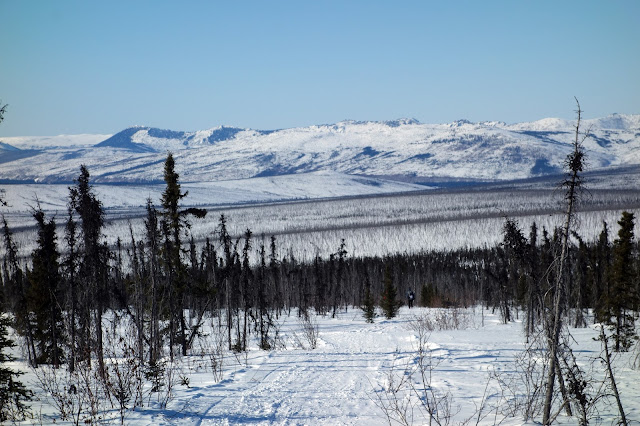
In "The Call of the Wild," Jack London more articulately described this sensation:
“He was mastered by the sheer surging of life, the tidal wave of being, the perfect joy of each separate muscle, joint, and sinew in that it was everything that was not death, that it was aglow and rampant, expressing itself in movement, flying exultantly under the stars.”
 |
| Friends! Danni and Wendy, with Bryon Powell and his phone in the background at the starting line of the WM100 |
This year, the 300-mile trek through soft snow to McGrath had left me with deeper fatigue than I'd anticipated. Prolonged muscle soreness in my upper legs led to suspicion about chronic exertional compartment syndrome of the quadriceps. But then I read more from Dr. Google and scolded myself. "You're not in pain like that. You're just being a baby because your leggies are tired." Over two weeks of "active recovery," I nearly regained the confidence I needed to start this race ... but then I took that ill-advised overnight trip to Eleazar's cabin last weekend.
 |
| Danni descending along the endless rollers to Moose Creek |
"Even if trails somehow set up after that storm, it's still 100 miles on dead legs," I grumbled to friends.
Fear of pain, injury and failure gnawed at my rational side, but I was still more influenced by "Fear of Missing Out" and the reality that several friends and acquaintances were flying up from the Lower 48 to participate, along with many kindred souls who I've connected with in nine years of Fairbanks visits and White Mountains 100s. Could I really see myself willfully if prudently dropping out of "The Best Race Ever ®"? No. No I could not.
 |
| Melanie Vriesman skiing past the trailside checkpoint above Moose Creek |
After a few miles of readjustments, I did some jogging (real running! At least, not walking. The motion felt so strange) and caught up to Wendy and Danni.
"How are you feeling?" Danni asked me.
"My legs hurt," I complained. "I mean, it's not that bad, but ... this is mile three."
 |
| A cyclist with tubeless tire failure returns to checkpoint one on the wind-drifted trail |
 |
| Descending toward Beaver Creek, with Cache Mountain in the background |
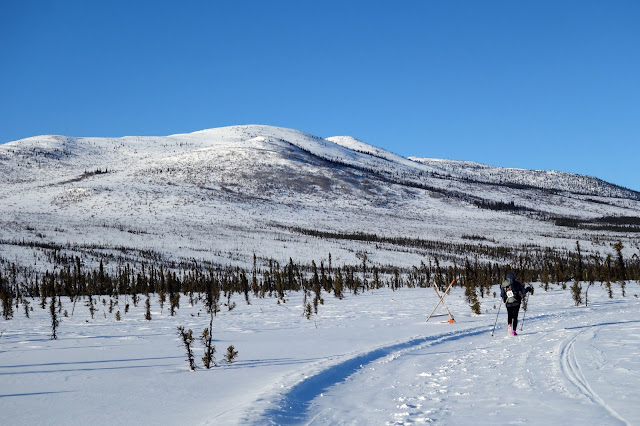 |
| Kathryn Bonuck of Portland, Oregon, on the drifted trail leading to Cache Mountain cabin |
 |
| Wendy approaching Cache Mountain cabin at sunset |
"Thanks, important stuff first," I replied as I removed my shoes and socks, hanging them over the wood stove to dry. I squeezed into a corner next to my friend Melanie and another Fairbanks skier I'd met at a bonfire earlier in the week, Christian. "Gotta dry your feet," I reasoned when they asked if I was leaving right away. Hurty feet were the one physiological issue I felt I could control, and I wasn't about to relinquish this.
"It's the wind," I said. "Breathing into this wind is just ... ugh. But I think it might be dying down finally. Do you have an inhaler with you?"
I'd hoped to travel most of the course with Danni, and regret not hanging around longer to see whether she recovered. My own experiences warned me that she probably couldn't recover in time to meet the 40-hour cutoffs. I barely boosted myself out the door after seven hours at Shell Lake, and still continued to struggle with my breathing for the next day and a half. Danni waited through the night and took a snowmachine ride out in the morning, enjoying the scenic route along McKay Creek and lunch at the Chatanika Lodge. One thing about Danni, she knows how to do DNFs right.
 |
| Approaching Cache Mountain Divide at dusk |
 |
| Aurora over Fossil Creek valley around 2 a.m. |
I was astonished how my brain could produce such depths of unbroken joy. I nearly always experience moments of euphoria during my longer endurance races, but this was literal hours in a sort of waking dream in which time stopped and I felt no pain. If I was a poet, I would write about the way the sky danced overhead as though solely for me, the beautiful, low-toned music that continued long after I resumed the moonlit march in silence, or how my whole body seemed to vibrate until I thought I might burst, such were my continued surges of energy after nearly 60 miles.
There were a few more occasions when I paused briefly to attempt to capture an image of the sky. As expected, the photos are disappointing. I look at them and think they don't begin to convey the truth, but then again, neither can my words.
 |
| Dawn in the depths of the cold |
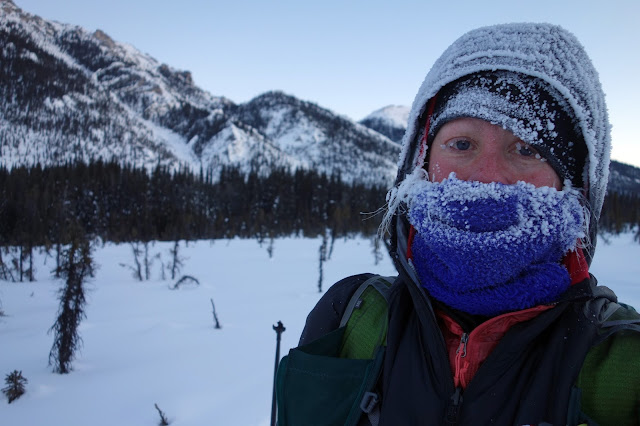
I left Windy Gap wearing my base layer, unzipped primaloft shorts, and soft-shell jacket. As dawn overtook the beautiful sky, a disconcerting creep of cold air settled around my body. I started by adding a mid-layer synthetic puffy jacket, then my fuzzy buff. I finally remembered to zip up my shorts and added fleece knee warmers over joints that now ached with cold. After another mile or so, a small panic set in and I made a longer stop to pull primaloft overboots over my cold toes (so glad I brought those!), mittens, and a thin wind shell between my two jackets. The only items that remained in my pack were my "emergency" down coat, thin shell pants, liner beanie, three pairs of used and slightly damp fleece or Drymax socks, one pair of dry socks, and thin over-mitts. My arms, cut off from better circulation by the backpack straps, remained cold, but I was loathe to put on that down coat. There's something deeply unsettling about using up all of my layers, meaning I have no safety buffer beyond fire-starters and an emergency bivy. This was the only point during the race when I remotely missed my sled.
 |
| First light over Fossil Creek. |
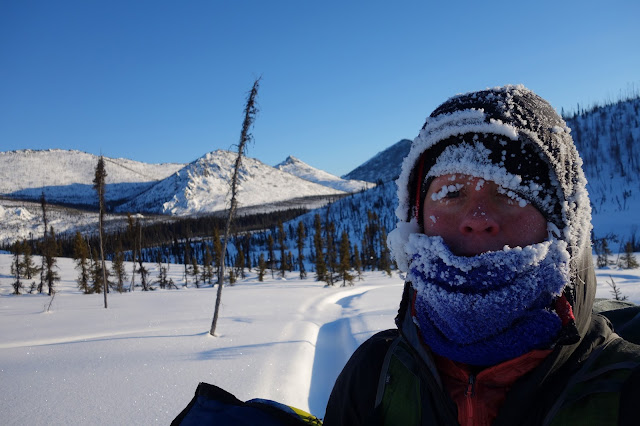 |
| Climbing out of Fossil Creek Valley well after sunrise. The cold stayed for a while. |
 |
| A long climb on much improved trail |
 |
| Surprised to see a biker pass me near mile 75. |
"So it's going to be a cooker today," I said like a smug Alaskan that I am totally not, and replaced my thick windproof hat with the still-damp liner hat, then removed my primaloft shorts, fleece socks and gaiters to help cool my legs. They were throbbing, and stiffened up immediately. Even with the swift retreat from Borealis, I could scarcely contain tears as I battled the rusty hinges to resume walking.
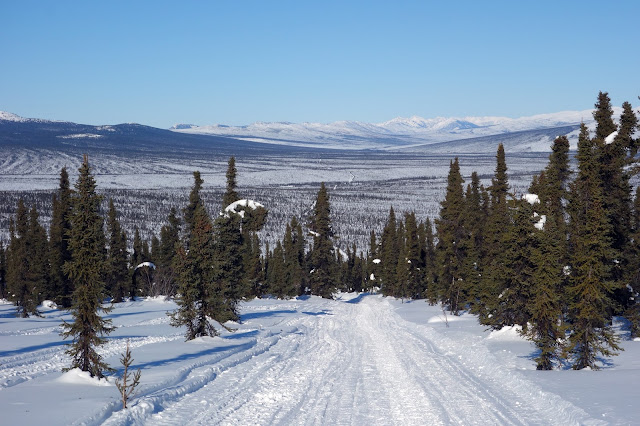 |
| View from the Wickersham Wall |
 |
| Photo by Danni Coffman, one mile before the finish |
"We'll be growing old and gray.
We'll be getting through the good times, same pain.
We'll be making the years go by like days,
Cause you're my forever, you're my forever, you're my always."
Through all this, I remembered my love for the White Mountains, for the familiarity and the surprise, the harshness and benevolence, the life-changing realizations, the highs and the lows. I gritted my teeth and glanced to the south, toward a ripple of rounded domes, the trans-Alaska Pipeline, hazy views of the Hayes Range — still beautiful, even through a lens of pain.
Danni hiked out to meet me a mile from the finish, and I was overjoyed to see her. About 50 yards before the finish, I saw Beat standing next to the trail in his big coat with a full beard and wind-burned face. It was the first time I'd seen him in a month.
"You're here," I wheezed, and reached out to embrace him before he could walk away and make me finish this race. "Congrats, you did awesome," I said, regarding his fourth finish in Nome, a place he'd reached just 48 hours earlier. He'd managed to grab a couple nights of rest, fly from Nome to Anchorage to Fairbanks, and drive my rental car to the Wickersham Dome trailhead while I plodded along the course.
Race director Joel handed me a belt buckle and let me officially finish before 6 p.m., for a time of 33:59. It's pretty far from the under-30-hour finish I managed in 2015, and blows away my pre-ITI hubris about walking the ITI350 to build bulletproof fitness for a fast time at the Whites. But damn, I actually made it through with only 20 percent grumbling, 40 percent striving, and 40 percent effortless and exhilarating awe. I couldn't ask for better odds if I dreamed the entire experience, which I'm still not 100 percent sure I hadn't.



























